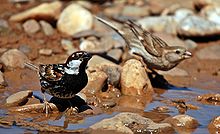Passer predomesticus
| Passer predomesticus Temporal range:
Middle Pleistocene | |
|---|---|
| Scientific classification | |
| Domain: | Eukaryota |
| Kingdom: | Animalia |
| Phylum: | Chordata |
| Class: | Aves |
| Order: | Passeriformes |
| Family: | Passeridae |
| Genus: | Passer |
| Species: | P. predomesticus
|
| Binomial name | |
| Passer predomesticus Tchernov, 1962
| |
Passer predomesticus is a
Taxonomy

The known material of Passer predomesticus consists of two
Tchernov argued that the house sparrow and related species have undergone considerable
Description

Premaxillae, the only bones from which Passer predomesticus is known, are generally relatively easy to identify to species in birds. Tchernov found that the two premaxillae of P. predomesticus most closely resembled the house and Spanish sparrows, but were distinct from either. In P. predomesticus, there is a central, longitudinal groove with raised margins running along the lower (ventral) side of the premaxilla. In contrast, the house and Spanish sparrows have a narrow crest in this position, which is more prominent in the house sparrow.[1][2] In the great sparrow, Cape sparrow (Passer melanurus), and southern grey-headed sparrow (Passer diffusus), this crest is more poorly developed, and they may even have a shallow groove at the front of the premaxilla, not nearly as well-developed as the groove in P. predomesticus. In P. predomesticus, the premaxilla has a maximum width of 8.0 millimetres (0.31 in) and the length from the tip of the premaxilla to the back of the nasal bones is 12.0 millimetres (0.47 in).[1][2]
Distribution
According to Tchernov's 1962 paper, Passer predomesticus was found in the middle
Although interpretations of the palaeoclimate at Oumm-Qatafa have differed, Tchernov suggested that the deposits are from a
References
- ^ a b c Tchernov 1962, pp. 102–103
- ^ .
- ^ Woolfenden 1965, p. 680
- ^ Mourer-Chauviré 1975, p. 212
- ^ Tchernov 1962, p. 103
- ^ a b c Tchernov 1984, pp. 94–95
- ^ a b Johnston & Klitz 1977, pp. 18–19
- ^ a b Summers-Smith 1988, pp. 278–279
- ^ a b Anderson 2006, pp. 9–10
- ^ Tchernov 1962, pp. 99–100
- ^ Tchernov 1962, pp. 100, 103–104
- ^ Tchernov 1962, p. 121
Works cited
- Anderson, Ted R. (2006). Biology of the Ubiquitous House Sparrow: from Genes to Populations. Oxford: Oxford University Press. ISBN 978-0-19-530411-4.
- Johnston, R. F.; Klitz, W. J. (1977). "Variation and evolution in a granivorous bird: the house sparrow". In Pinowski, Jan; Kendeigh, S. Charles (eds.). Granivorous birds in ecosystems: Their evolution, populations, energetics, adaptations, impact and control. ISBN 978-0-521-21504-6.
- Mourer-Chauviré, C. (1975). "Les oiseaux du Pléistocène moyen et supérieur de France". Documents des Laboratoires de Géologie de la Faculté des Sciences de Lyon (in French). 64 (parts 1 and 2): 1–261, 263–624.
- Summers-Smith, J. Denis (1988). The Sparrows: a study of the genus Passer. illustrated by ISBN 978-0-85661-048-6.
- Tchernov, E. (November 1962). "Paleolithic avifauna in Palestine". The Bulletin of the Research Council of Israel, Section B. Zoology. 11 (3): 95–131.
- Tchernov, E. (1984). "Commensal animals and human sedentism in the Middle East". In Clutton-Brock, J.; Grigson, C. (eds.). Animals and Archaeology. Vol. 3. B.A.R. pp. 91–115. ISBN 978-0-86054-207-0.
- Woolfenden, Glen E. (October 1965). Woolfenden, Glen E (ed.). "Recent Literature" (PDF). The Auk. 82 (4): 667–680. JSTOR 4083245.
